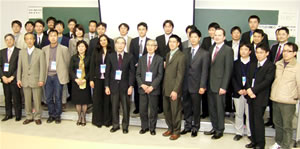- Research Area within Sakigake (PRESTO) Program,
“Evolution of Light Generation and Manipulation”, Sakigake Forum -
(Frontier and New Prospects in Optical Science)
(“The 2010 57th Spring Meeting of the Japan Society of Applied Physics (JSAP) Symposium” Special Event)
In the research area of the "Evolution of Light Generation and Manipulation" within the PRESTO program a debriefing session on the results achieved was held along with those from the completion of research of six Term-2 scientists by inviting Dr. Koichi Shimoda, a Culture Merit scientist, and 5 other foreign up-and-coming researchers who are familiar to the Term-2 scientists as one of the symposiums held at the 2010 Spring Meeting of the Japan Society of Applied Physics (JSAP). In addition to a keynote lecture being made by Dr. Koichi Shimoda, who has been active from early on in the development of lasers and at the forefront of optical science studies in Japan, the Term-2 scientists, then followed by the Term-1 and the Term-3 scientists, held poster lectures and discussed the theme of a new paradigm that is expected to be result from the nature of optical sciences.
As well as presenting the results of PRESTO program research at the international level heated discussions in terms of future technology deployment were made. The results of the research were highly evaluated and the lecture ended with introduction of the research system used in the PRESTO program to develop researchers, which was highly admired by overseas researchers. Dr. Shimoda encouraged all the young researchers, with all the participants providing valuable opinions and views on the future of optical sciences. The opinions, proposals, and experiences provided must have been incredibly valuable to the young PRESTO researchers.
The lectures held this time can be roughly classified into the following four fields: (1) Quantum Optics, Atomic Optics, (2) Plasmonics, Nanophotonics, (3) Ultrafast infrared/terahertz science, and (4) Biomedical Optics and Photomedicine.
Four presentations were made at lecture (1) on the theme of an "Optical Quantum Computer: A Secure Way of being the First to Realize One in the World". Utilizing the fundamental principle of a field of physics known as quantum mechanics could be used to produce a "quantum computer" that would be overwhelming powerful in comparison to existing computers. A quantum computer realizes the basic unit of information known as "bits" with "photons", which are fundamental particles of light; however, the problem has been that the photons do not interact with each other (they actually pass through each other). At this symposium a new theory was revealed where photons can interact with each other, thus creating a "quantum gate", with the experimental results directly leading to that realization being presented. The realization of a quantum gate with an actual physical system was a global first. These element technologies are almost reaching completion in Japan, thus providing us with the feeling that the realization of the world’s first quantum computer may occur in the near future in Japan.
Two presentations were made at lecture (2) on the theme of the "Expression of a Novel Optical Function with a Metal Nanostructure". A lecture was made on ultra-large capacity optical memory that can store information in a five dimensional space through utilization of a new artificial optical function material which consists of a metal nanostructure called a plasmonic meta-material, laser processing technology developed to process the material, and a material that has gold nanorods dispersed within it. Plasmonics and nanophotonics are part of new optical technology that actively utilizes the interaction between nanoscale microstructures and light. Possible new optical technologies that will open up through use of above the technologies were then heatedly discussed.
Two presentations were made at lecture (3) on the theme of "Visualization of Energy Transmission between Water Molecules". In this session the development of innovative technologies in this field that included the generation of "ultra-short pulse infrared rays" which only oscillate several times in an electric field per pulse and stabilization technology for the carrier-envelope phase were presented. The ultra-short pulses enabled the transmission of energy in water molecules to be successfully "viewed" at the minute scale of 100 femtoseconds (or one 10 trillionth of a second). The overall picture of the role of water in life phenomenon is therefore now capable of being clarified.
Three presentations were made at lecture (4) on the theme of "A Global First: ‘Order’ of Light to Stem Cells". Regenerative medicine is a type of medicine where lost tissues and organs can be repaired or regenerated using cells produced by culturing the cells or organs of the person themselves or others to use in the creation of a substitute for the disordered organ. Irradiating stem cells harvested from bone marrow result in cells that produce bone. The presentation confirmed a global first that stem cells could be safely turned into the intended cells through utilization of optical technology. Heated discussions then took place on the development of a new research field involving the cell functions being controlled with optical technology not only in research with stem cells but also various other cells such as those that are the cause of allergies and those that produce insulin.
Active exchanges of opinions took place at all the respective lectures, including the general participants of JSAP, and the poster sessions were so popular that heated discussions took place in front of the posters, even after the session had actually finished.
As well as last year a public debriefing session on the results of the PRESTO program was held in the place of an academic society lecture. There were as many as 380 participants and many of the sessions only had standing room. An air of excitement unified the lecturers and other participants at the conference, somewhat similar to "Call and Response" in jazz terms, something we really appreciated.

JST, an integrated organization of science and technology in Japan, establishes an infrastructure for the entire process from the creation of knowledge to the return to the society. For more information, visit http://www.jst.go.jp/EN/